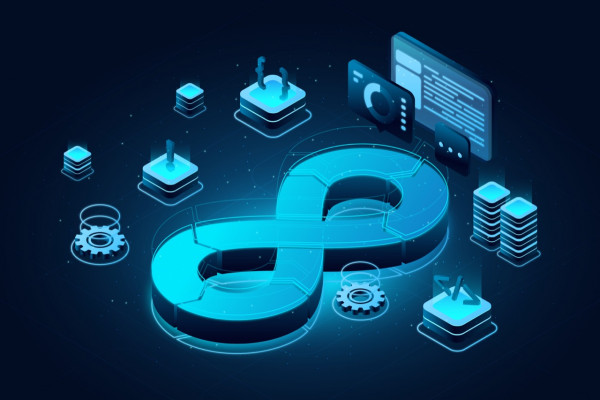Online and offline businesses share more parallels than one possibly can imagine. Creating a solid digital presence is as important as operating offline. However, switching work modes is not enough; companies should incorporate physical business components into the digital sphere. Cyber security is one such component.
Similar to physical office break-ins resulting in a data breach, the online landscape experiences cybersecurity vulnerabilities. During the pandemic, daily cybercrime reports increased by 300 to 400%. The average data breach cost in 2021 rose to US$4.24 million. Therefore, having a robust cybersecurity framework is crucial to avoid data leaks—this is where Managed Security Services and Threat Intelligence come in.

Image Credit:- ISACA
Types of Cyber Security Threats
Knowing the different cyber security threats will help you understand how Managed Security Services help businesses. The four primary cyber security attacks are phishing, ransomware, malware, and insider threats.
Phishing
Phishing is one of the most common and damaging cybersecurity breaches that companies face. Phishing attacks usually occur through emails. Attackers send emails containing virus links. When clicked on, these links download harmful files on your device, giving the attacker access to confidential information. 90% of data breaches that organizations experience are due to phishing attacks. Furthermore, each successful phishing fraud costs US$3.8 million. So, not only do phishing attacks compromise account details, but they also result in severe financial loss.
Ransomware
Another widespread cyberattack, ransomware targets thousands of organizations annually (mainly small and medium-sized enterprises). In 2021, ransomware attacks targeted 649 US companies, and the attempts have increased. Unlike phishing threats that attack directly, ransomware operates under the table. This attack encrypts sensitive business information, rendering it unusable to inaccessible. The company then has to pay the attacker a hefty sum to undo the damage. Companies face loss either way, whether losing confidential data or money. REvil was the most common ransomware attack observed in 2021, accounting for 37%.
Malware
Malware attacks are one of the costliest cyber threats, costing organizations US$2.4 million. Primarily code-based, these attacks target companies through computer viruses. Attackers use coded attacks to gain access to otherwise unauthorized networks to steal data or cause internal damage. Various sources, such as unreliable websites or virus-infected attachable drives, lead to malware attacks. Along with gaining company data, malware attacks also provide attackers with employee and client information.
Insider Attacks
Insider attacks occur due to intentional or negligent damages caused by employees or business associates. Intention insider attacks include insider trading and deliberately deleting or tampering with critical files to damage internal functions. Unintentional insider threats are due to carelessness regarding contracts or customer data. For instance, a team member could accidentally leak sensitive files (88% of data breaches happened due to employee errors), or a former associate could breach data deliberately.
What are Managed Security Services?
Third-party specialists provide Managed Security Services to solidify and strengthen a company’s security system. Managed Security Service Providers (MSSPs) offer various security tools, such as security management and incident management. From overseeing specific security patches to providing overall assistance, MSSPs offer customized services.
Often, organizations lack the proper resources or awareness to strengthen their security or need more expertise to install a better framework. Alternatively, some companies struggle to train their employees on crucial security protocols. In such cases, MSSPs ensure enterprises have the required skills and resources to monitor and improve the security status.
MSSPs help organizations navigate business risks. Their industry knowledge keeps them in the loop regarding regulatory compliance. Companies, regardless of size and industry, must follow regulatory guidelines. MSSPs ensure companies follow the guidelines in a financial-savvy manner while reducing security vulnerabilities.
How Do MSSPs Combat Cybersecurity Risks?
Despite the increasing urgency for more robust cybersecurity, many enterprises put the need for better IT security on hold. Ultimately, they experience data loss, costing them time, money, and client trust. As cyberattacks become more frequent and unpredictable, companies must employ additional security measures. MSSPs help them strengthen IT security by using:
- Cloud Security
- Secure networks
- Data loss prevention, recovery, and backup
- Secure web applications
- Endpoint security
- Encrypted security operation points
Managed Security Services counter cybersecurity attacks in 3 steps:
Threat Identification
The first step toward preventing cybersecurity risks is threat identification. An MSSP will conduct a thorough IT framework inspection to track potential security threats by using anti-virus software and securing the device from ransomware or malware attacks.
Assessing Emails
Most phishing emails are sent to the spam folder. However, despite the mail sitting in the spam folder, employees tend to open it and click on a malicious link accidentally. At least one employee in 86% of companies clicked a phishing link. MSSPs use specialized measures to vet harmful or unauthorized links and potential ransomware and install security software to prevent one from tapping on these links.
Network Monitoring
The next step entails observing network performance. Managed Security deploys both automated and manual measures to monitor servers. Automated tools detect potential vulnerabilities automatically, whereas manual assistance will help in case of software malfunction, downtime, or technical emergencies.
What is Threat Intelligence?
Preparing is wise and needed in today’s world, where cyberattacks can change an organization’s course. Cyber or Threat Intelligence is information companies use to monitor past and present security challenges. This information allows them to study past data breach patterns to prepare accordingly. Monitoring previous attacks helps them identify and eliminate potential threats, keeping their files secure.
Cyber Intelligence helps enterprises extract details about different cyber threats, such as malware and phishing attacks. Understanding cyber threats and their behaviors allow companies to design effective countermeasures.
How Does Threat Intelligence Reduce Cybersecurity Risks?
Threat Intelligence provides organizations with a comprehensive report of existing and potential cyber threats and their impact. TI then develops a protection strategy to strengthen the IT infrastructure and prevent cyberattacks. Depending on the IT framework and scope of the risk, there are three types of Threat Intelligence measures:
Strategic Measures
This measure tackles questions of who. It uncovers the motive behind the attack to identify the attacker. Strategic intelligence measures analyze threat patterns to determine whether the vulnerability is an insider threat or a third-party attack. It generates reports detailing its findings to prepare an action plan.
Tactical Measures
Next comes the questions of where and how. A company’s cyber division has multiple sub-divisions, such as planning, testing, and executing. Tactical measures identify which department and technologies the attacker plans to target. This type of Threat Intelligence strategy allows IT professionals to prepare accordingly.
Operational Measures
Operational strategies assess current attacks, past threats, and outside data, such as links and IP addresses. Monitoring these avenues allows IT teams to detect and block incoming attacks and reduce their impact.
In Conclusion
Investing in Managed Security Services and Threat Intelligence is crucial in the digital age. These two security measures emphasize the need to spread cyber awareness. Companies are constantly at risk of cyberattacks that can result in data and monetary loss. Managed services and cyber intelligence ensure organizations are always ready and prepared to prevent digital threats and make secure long-term investments.



